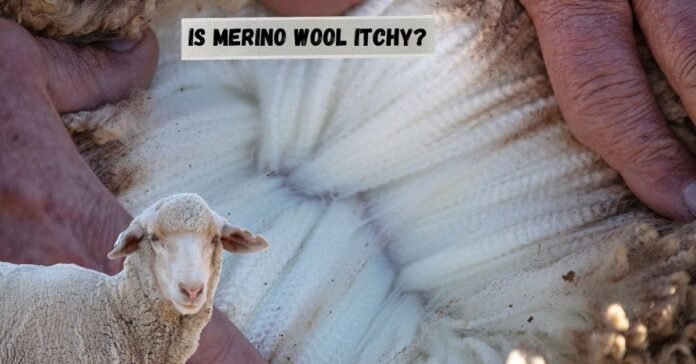Wool is not new in its reputation of being warm, yet the most often complaint about it is that it is itchy. Most individuals closely relate wool to itchy sweaters or annoying scarves which do not feel good on the skin. But not all wool can be considered the same.
This leads us to a logical question: Is merino wool itchy? Merino wool is extremely soft and gentle as compared to traditional wool. It is made of a special breed of sheep and provides warmer than many first time wearers expect. Actually, merino wool is frequently employed in the under-garments and even the baby clothes, and it turns out to be soft and versatile.
In this paper we are going to discuss the reasons why certain wool is itchy, why merino wool is not, and what makes it one of the most comfortable natural fabrics existing today.
What Is Merino Wool?
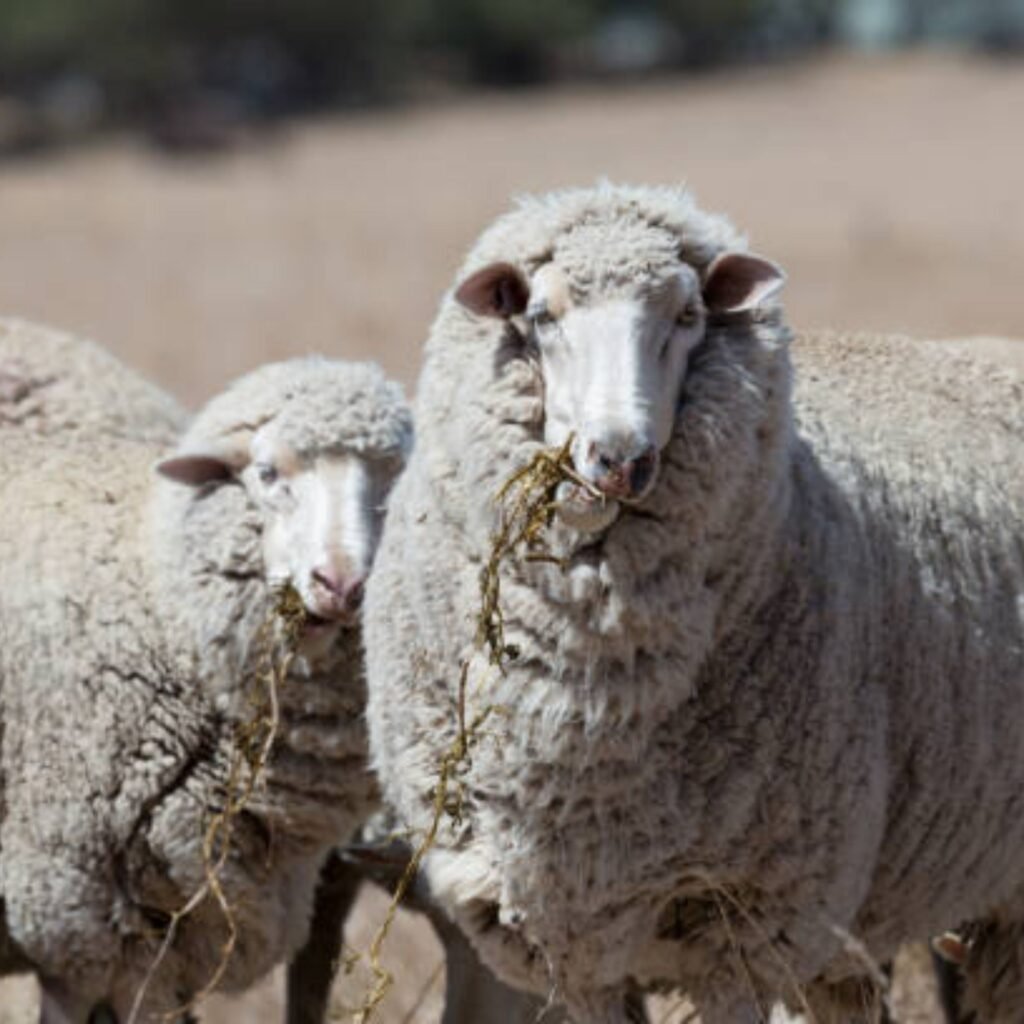
Merino sheep a breed of wool first discovered in Spain but today reared all over the world, especially in Australia and New Zealand, are the source of merino wool. What makes this wool special is its fine and soft fibers which are very different to the traditional wool.
The merino wool fibers are quite finer, typically in the range of 1723 microns whereas normal wool fibers have a length of more than 30 microns. It is this varnish of thickness that renders merino wool soft and luxurious and coarse ones may irritate.
In addition to being soft, merino wool is naturally breathable, a thermostat, and a moisture-wicking fiber making it an ideal year-round wear. The merino is not as bulky as wool; therefore, it can be turned into fine fabrics and thus designers can make everything starting with the athletic clothes and up to the elegant sweaters.
Concisely, merino wool is a high quality fabric and it is soft, comfortable and performs so it is absolutely nothing like the itchy wool that most people recall.
Why Some Wool Feels Itchy?
Fiber Thickness (Micron Count)
Wool fiber thickness is one of the significant factors in its feel. Coarser fibers are less bent and they pierce the skin, resulting in itchiness.
Coarse Fibers in Regular Wool Irritate Skin
Ordinary wool can contain thick stiff fibers, which scratch the skin. This is uncomfortable, particularly to sensitive persons.
Natural Sensitivity to Wool in Some People
Others have more sensitive skin to wool, including still softer wool. They can be irritated a little because of their sensitivity.
Is Merino Wool Itchy?
The plain answer would be no–merino wool is not usually itchy. Its ultra-fine fibers provide it with the ability to touch the skin and make it smooth and soft. Merino fibers do not require straightening as traditional wool does, and this aspect eliminates that poking feeling that comes with rough garments.
High-quality merino wool, especially garments with a micron count under 19.5, feels as comfortable as cotton or even cashmere. This delicacy enables individuals of delicate skin to wear it without any pain.
By your question, then, are merino wool itchy,–merino wool, indeed, is one of the least itchy wools you can purchase.
Factors That Affect Wool Itchiness
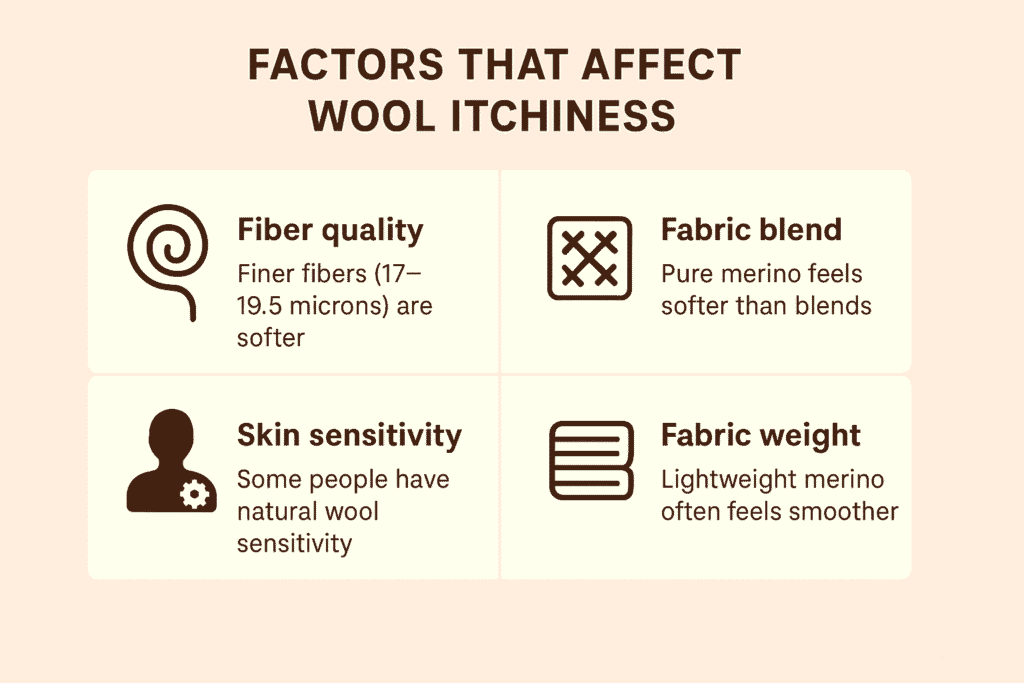
- Fiber quality (number of microns) — When referred to as superfine or extra fine, wool with fibers around 17–19 microns is considered by many. Such low micron counts result in a fabric that is very soft. In comparison, merino which is described as regular (e.g. 23-34 microns) might be a bit less soft. Generally, smoother, smaller fibers of wool equates to a more comfortable feel and less itch.
- Fabric blend (pure vs. blends) – Clothing that is 100% merino wool will most probably be soft. Other fibers (such as nylon or coarse wool) are sometimes used in combination with merino to provide strength or stretch. The texture can be altered with a heavy blend. When a garment has large amounts of synthetic or rough wool, it may not be so soft or even scratchy. For the least itch, choose pure merino or blends with mostly merino.
- Sensitivity and allergies on the skin – Human beings react differently on the skin. Even fine fabrics can feel different in case you have very sensitive skin. New wool may irritate some, but a thin layer of cotton base clothing usually puts an end to that. True wool allergies are rare. Nevertheless, when you are aware of your reactions to wool, seek out merino of superfine quality and apply it to a small area of the skin.
- Weight of fabric (light or heavy) – Lightweight is generally softer and more smooth and wraps beautifully around the body (thin base layers, tees or socks). Heavy knits (thick sweaters, thick hats) are warmer but perhaps a little bulky. Light weight or delicate merino is preferable to be as comfortable as possible.
Benefits of Merino Wool Beyond Softness
Moisture-Wicking and Breathability
Merino wool can absorb moisture and evaporate it naturally making the skin dry. It is perfect in the activewear sector as it is ideal among all athletes and hikers.
Odor Resistance
Merino wool does not generate odors as a result of bacteria unlike the synthetics. It smells fresher compared to the other fabrics even after several wears. The feature has value in travel and sports clothing.
Temperature Regulation
Merino fibers trap air and assist in regulating the body temperature. They are handy to use in all seasons as they warm you in winter and cool you in summer.
Durability and Comfort
Although merino wool is soft, it is powerful and tough. It does not wrinkle and maintains its form, and provides durability in comfort.
How to Choose Non-Itchy Merino Wool
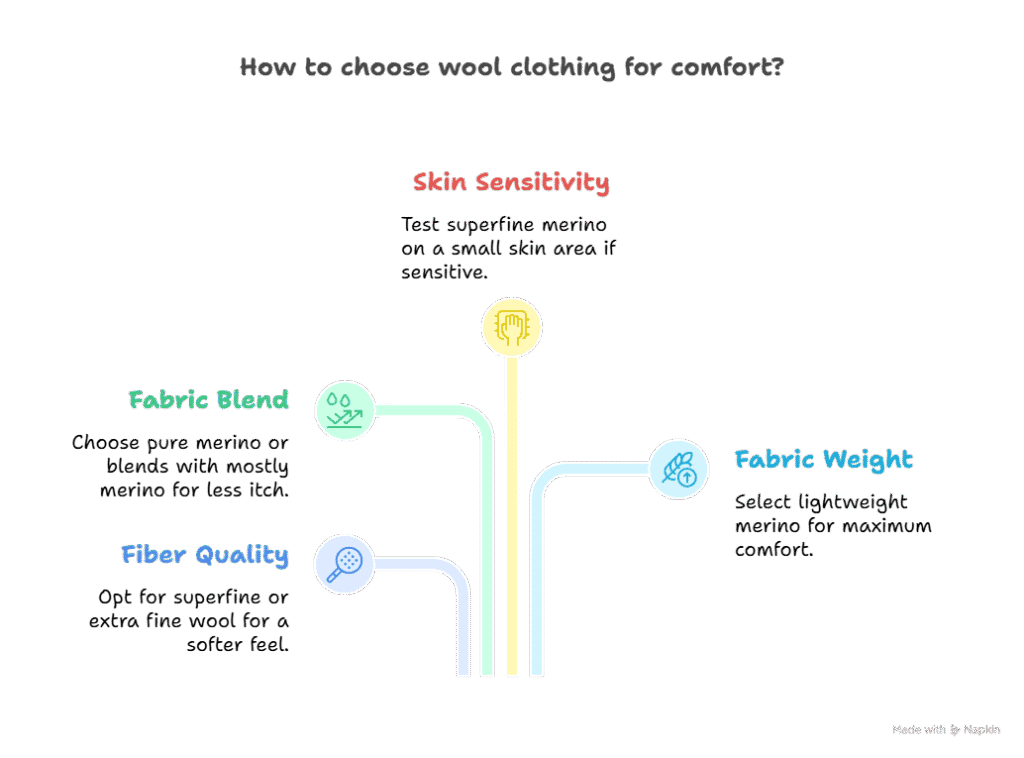
- Find fine counts of the microns – See whether the label is extrafine or superfine merino (approximately 17-19microns). It can be on labels with micron number or wool grade. Smaller fibers are guaranteeing smoother material.
- Select well-known brands-Established brands which specialize in merino wool tend to dictate the quality of the fibers. They usually ensure a soft touch and can state the number of microns. Reliable brands are not likely to be filled with harsh or synthetic stuff.
- Check 100 percent merino versus blends– Find out whether the garment is 100 percent merino wool. A 100 per cent merino product will feel different (usually softer) as compared to one mixed with other yarns. When you have very sensitive skin, you can begin with pure merino then progress to blends.
- Wear light clothes on delicate skin – Start with clipper merino clothing in case your skin is especially sensitive. First up: lightweight T-shirts or base layers or socks. They demonstrate the softness of merino in direct contact with your skin. Keep heavy sweaters or thick knits in reserve in case you need the utmost amount of warmth and are aware of how they fit or feel on your body.
Merino Wool vs Other Fabrics
Merino Wool vs Regular Wool
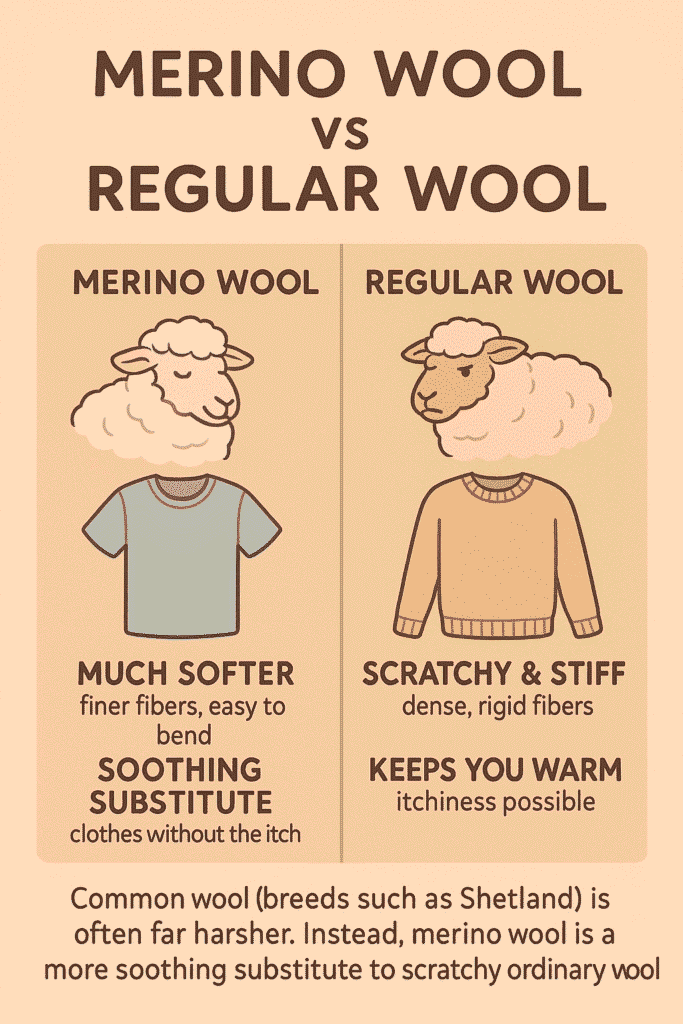
Common wool (breeds such as Shetland or generic wool sweaters) is often far harsher. Its fiber are dense and rigid and therefore tends to be scratchy and stiff. Instead, merino wool is much, much softer. Merino clothes are smooth because the finer merino fibers are easy to bend rather than poke. In short, merino wool is a more soothing substitute to scratchy ordinary wool. Both will keep you warm but merino will do it without the itch. This led to a consequential popularity of merino items (socks, tees, etc.) with many people who could not tolerate traditional wool.
Merino Wool vs Cashmere
Cashmere is famous because of its unsurpassable fluffiness and poshness, frequently described as more delicate than merino. But merino wool is much more flexible and strong, such that it could be used both in outdoor performance apparel and in daily clothing. Both types of fibers are non-itchy and comfortable, but merino is more effective at moisture-wicking and temperature-regulating. It is something that makes merino wool an convenient option to individuals seeking both softness and functionality.
Merino Wool vs Synthetic Fabrics
Artificial fabrics such as polyester and nylon are fast drying, but can become stifling and stale causing unpleasant smells with time. Instead, merino wool is naturally odor resistant and breathable, as well as, comfortable to the skin. It also has good temperature regulation unlike the synthetics hence can be used in both warm and cold climates. For long-lasting comfort, softness, and performance, merino wool outshines synthetic alternatives.
Common Myths About Merino Wool
“All Wool Is Itchy.”
This is false. Merino wool manages to demonstrate that not every wool is scratchy. It is soft and can be worn because of its fine fibers.
“Merino Wool Is Too Delicate.”
Merino is softer compared to ordinary wool and is durable. When well maintained it can even take years before it diminishes.
Merino Wool Only in Winter.
Merino controls the temperature, which is ideal both in cold and hot seasons. It is worn by a lot of athletes not only during the summer but it is cooler and breathable.
How to Care for Merino Wool to Maintain Softness
 Wash gently: Merino wool should be washed in cool or lukewarm water and on a gentle cycle (or by hand) always. The fibers can be shrunk or felt by hot water and rough washing. Wearing clothes inside out and mesh laundry bag may assist in preserving the fabric.
Wash gently: Merino wool should be washed in cool or lukewarm water and on a gentle cycle (or by hand) always. The fibers can be shrunk or felt by hot water and rough washing. Wearing clothes inside out and mesh laundry bag may assist in preserving the fabric. Use wool-friendly detergent: Avoid standard detergents, bleach, or fabric softeners on merino. These severe chemicals are able to decompose wool proteins and may render the fabric coarse. Rather, apply a soft wool or sensitive cycle detergent, or a wool/cashmere shampoo.
Use wool-friendly detergent: Avoid standard detergents, bleach, or fabric softeners on merino. These severe chemicals are able to decompose wool proteins and may render the fabric coarse. Rather, apply a soft wool or sensitive cycle detergent, or a wool/cashmere shampoo. Air dry: Rinse the garment, then press or roll in a towel to dry the garment, but not wring or twist. Redo the item and either lay it flat or hang to dry. Do not tumble dry, because heat and agitation may shrink wool. Merino fibers are happy and soft when they are air dried.
Air dry: Rinse the garment, then press or roll in a towel to dry the garment, but not wring or twist. Redo the item and either lay it flat or hang to dry. Do not tumble dry, because heat and agitation may shrink wool. Merino fibers are happy and soft when they are air dried.
Conclusion-
So, is merino wool itchy? The fact is that it is among the softest and the most comfortable natural fabrics out there. The ultra-fine fibers of merino do not irritate the skin as compared to regular wool. Merino wool is soft, yet practical and versatile because of such advantages as breathability, resistance to odor, and ability to control the temperature. When you buy high-quality merino products, you are guaranteed of long-lasting wear and style.
Merino wool is the right option you should use in case you were previously avoiding wool due to its itchiness. Feel how soft it is, and you will wake up to never again look at wool in the same light.
Read More>> About itchiness of Alpaca wool.
FAQs
Cashmere is said to be the softest natural material yet high quality merino wool is very close in terms of comfort. Although cashmere is silky to touch, merino is better and more durable to wear every day. Merino wool is usually smooth and non-itchy to most individuals and it can also compete with cashmere.
Most of the sensitive-skinned people can indeed wear merino wool as it has ultra-fine fibers that make it so comfortable. It is not erratic like coarse wool to poke or irritate the skin and is therefore soft enough to touch. Nevertheless, people who are too allergic to wool should use a small piece of clothing initially to guarantee comfort.
That is true, merino wool tends to soften as it is used and gently washed. These fibers become more relaxed and adjustable, and this makes the skin feel smoother. Merino is not only soft but saves its form and nature many years with proper care.
No, merino wool in fact does well in the face of most fabrics even during sweating. It has natural capabilities of wicking away moisture which would otherwise result in dampness that would irritate. As opposed to sticking on the skin, merino will make you dry, comfortable and even itch free even when you are on the move.
No, merino wool is frequently used in baby- and children-clothing due to its softness and safety. It has fine fibres, which are soft on sensitive skin as compared to the traditional wool which is scratchy. Parents rely on merino when it comes to creating items such as baby blankets, sleepwear and base layers.
